|
|
|
Sort Order |
|
|
|
Items / Page
|
|
|
|
|
|
|
| Srl | Item |
| 1 |
ID:
106296
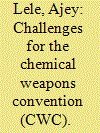

|
|
|
| 2 |
ID:
005789
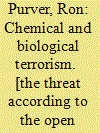

|
|
|
|
|
| Publication |
Canadian Security Intelligence Service, 1995.
|
| Description |
212p.
|
|
|
|
|
|
|
|
|
|
|
|
Copies: C:1/I:0,R:0,Q:0
Circulation
| Accession# | Call# | Current Location | Status | Policy | Location |
| 037225 | 303.625/PUR 037225 | Main | On Shelf | General | |
|
|
|
|
| 3 |
ID:
090640
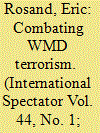

|
|
|
|
|
| Publication |
2009.
|
| Summary/Abstract |
The Bush administration's strong preference for seemingly more flexible initiatives, involving a select group of countries, and limiting the size of international bureaucracies, which has resulted in three US-driven multilateral initiatives to address the threat of WMD-terrorism - the Proliferation Security Initiative, the G-8 Global Partnership Against the Spread of Weapons of Mass Destruction, and United Nations Security Council Resolution 1540 and the committee and group of experts it established - has produced mixed results so far. Although it helped to ensure a more rapid initial response to WMD terrorism, such an approach has also impeded efforts to build and sustain global support to respond to that threat
|
|
|
|
|
|
|
|
|
|
|
|
|
|
|
|
| 4 |
ID:
073006
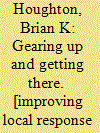

|
|
|
|
|
| Publication |
Rand Corporation, Santa Monica, 2004.
|
| Description |
xiii, 185p.
|
|
|
|
|
|
|
|
|
|
|
|
Copies: C:1/I:0,R:0,Q:0
Circulation
| Accession# | Call# | Current Location | Status | Policy | Location |
| 051470 | 363.325350973/HOU 051470 | Main | On Shelf | General | |
|
|
|
|
| 5 |
ID:
062768
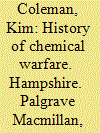

|
|
|
|
|
| Publication |
Hampshire, Palgrave Macmillan, 2005.
|
| Description |
xxiii, 198p.
|
| Standard Number |
1403934606
|
|
|
|
|
|
|
|
|
|
|
|
Copies: C:1/I:0,R:0,Q:0
Circulation
| Accession# | Call# | Current Location | Status | Policy | Location |
| 049768 | 358.3409/COL 049768 | Main | On Shelf | General | |
|
|
|
|
| 6 |
ID:
126117
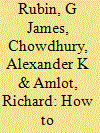

|
|
|
|
|
| Publication |
2012.
|
| Summary/Abstract |
A deliberate attack involving chemical, biological, radiological, or nuclear (CBRN) material has the potential to cause substantial fear among the public. This presents problems for communicators, who will need to provide information quickly after an attack while ensuring that their messages are easily understood and likely to be attended to by members of the public. Identifying in advance what people would want to know, where they would get information from, and how messages should be presented might allow communicators to ensure that their messages have the best chance of having their desired effect. In this review, we identified all peer-reviewed studies that have assessed communication strategies or information needs using hypothetical CBRN scenarios or in actual CBRN incidents. We identified 33 relevant studies. Their results support existing psychological models of why people engage in health protective behaviors, with information about the severity of the incident, the likelihood of being exposed, the efficacy and costs or risks of recommended behaviors, and the ability of individuals to perform recommended behaviors being sought by the public. Trust plays a crucial role in ensuring that people attend to messages. Finally, while a large variety of spokespeople and sources were identified as being turned to in the event of an incident, the use of multiple information sources was also common, affirming the importance of communicating a consistent message through multiple channels. Further research is required to extend these predominantly US-based findings to other countries and to confirm the findings of research using hypothetical scenarios.
|
|
|
|
|
|
|
|
|
|
|
|
|
|
|
|
| 7 |
ID:
140229
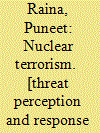

|
|
|
|
|
| Publication |
DelhI, Gaurav Book Centre Pvt Ltd, 2015.
|
| Description |
vii, 296p.hbk
|
| Standard Number |
9789383316120
|
|
|
|
|
|
|
|
|
|
|
|
Copies: C:1/I:0,R:0,Q:0
Circulation
| Accession# | Call# | Current Location | Status | Policy | Location |
| 058290 | 363.32550954/RAI 058290 | Main | On Shelf | General | |
|
|
|
|
| 8 |
ID:
155593
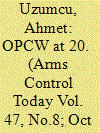

|
|
|
|
|
| Summary/Abstract |
This year marks the 20th anniversary of the entry into force of the Chemical Weapons Convention and the founding of the Organisation for the Prohibition of Chemical Weapons (OPCW). Today, the convention remains the foundation of the international community’s commitment to eliminate the scourge of chemical weapons.
|
|
|
|
|
|
|
|
|
|
|
|
|
|
|
|
| 9 |
ID:
110764
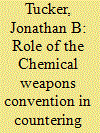

|
|
|
|
|
| Publication |
2012.
|
| Summary/Abstract |
A series of incidents over the past two decades has indicated that some terrorist groups are interested in acquiring and using improvised chemical devices (ICDs). Although the 1993 Chemical Weapons Convention (CWC) is a disarmament treaty that is legally binding only on sovereign states that join it voluntarily, the Convention fortuitously includes several provisions that can help its members to prevent chemical terrorism or to manage the consequences of an attack. This article examines the articles of the CWC that are relevant to counterterrorism and discusses how their implementation could be improved at the national and international levels. The article also addresses the role that the CWC secretariat, the Organization for the Prohibition of Chemical Weapons (OPCW) in The Hague, currently plays in preventing and responding to incidents of chemical terrorism, and the political factors that constrain its activities in the counterterrorism field.
|
|
|
|
|
|
|
|
|
|
|
|
|
|
|
|
| 10 |
ID:
050721
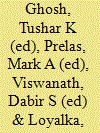

|
|
|
|
|
| Publication |
New York, Marcel Dekker, 2002.
|
| Description |
xviii, 581p.
|
| Series |
Public administration and public policy
|
| Standard Number |
0824708709
|
|
|
|
|
|
|
|
|
|
|
|
Copies: C:1/I:0,R:0,Q:0
Circulation
| Accession# | Call# | Current Location | Status | Policy | Location |
| 047800 | 363.32/GHO 047800 | Main | On Shelf | General | |
|
|
|
|
| 11 |
ID:
119443
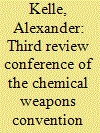

|
|
|
|
|
| Publication |
2013.
|
| Summary/Abstract |
States parties to the Chemical Weapons Convention (CWC) will convene for the Third Review Conference of the treaty in April 2013.
With the destruction of chemical weapon stockpiles more than 75 per cent complete and ongoing changes in the scientific, industrial and security environment in which the CWC operates, some have argued that major adaptations in the implementation of the treaty are required. However, on the basis of regular participant observation at CWC meetings of states parties and extensive document analysis this article argues that changes in treaty implementation will be only of an incremental nature with the Organization for the Prohibition of Chemical Weapons (OPCW) taking on new tasks in the areas of chemical terrorism and safety and security, alongside traditional core areas of activity in CWC implementation such as verification of chemical weapon disarmament, non-proliferation or, rather, non-acquisition of chemical weapons, protection and assistance against the threat or use of chemical weapons, and international cooperation in the peaceful uses of chemistry.
Taking into account the evolution of these areas of concern in combination with the consensus-based institutional culture of the OPCW supports the expectation of only incremental changes being adopted at the Third CWC Review Conference. These expectations tie in with the findings of organizational analyses in other political contexts, which highlight the path dependency of many institutions once they are created.
|
|
|
|
|
|
|
|
|
|
|
|
|
|
|
|
|
|
|
|
|